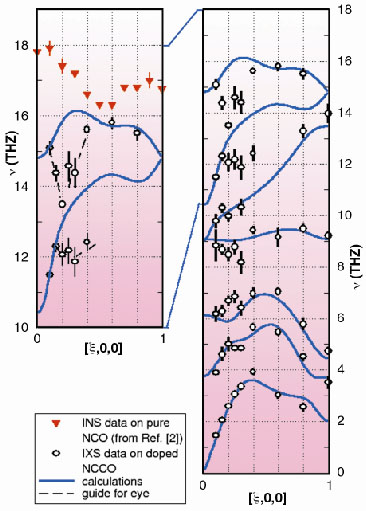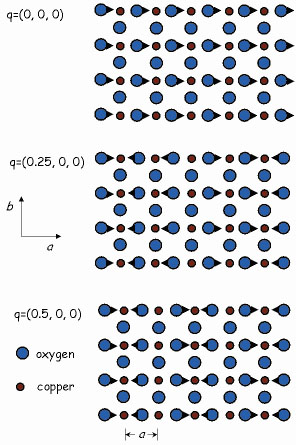- Home
- Users & Science
- Scientific Documentation
- ESRF Highlights
- ESRF Highlights 2001
- Collective Atom Dynamics
- Anomalous Dispersion of Optical Phonons in High Tc Superconductors
Anomalous Dispersion of Optical Phonons in High Tc Superconductors
Copper oxide superconductors exhibit the highest critical temperature found so far. Since their discovery in 1986, the microscopic mechanism at the origin of their superconductivity is still unexplained [1]. While it is well established that in conventional superconductors the coupling between electrons and phonons (collective vibrations) leads to charge carrier pairing, and therefore superconductivity, the role of this coupling in copper-oxide superconducting compounds is still the subject of intense research efforts. Inelastic neutron scattering (INS) studies on some hole-doped high-temperature copper oxide superconductors revealed an anomalous behaviour of the highest energy optical phonon mode, related to the Cu-O in-plane bond stretching vibrations [2]. This anomaly may be related to a strong coupling between the lattice vibrations and the charge carriers, as the conduction in the copper oxide superconductors takes place by charge hopping along the Cu-O bond in the CuO2 planes. Within this framework, the optical phonon anomaly is expected to be ubiquitous, and therefore should also be observed in electron-doped copper oxide superconductors, such as Nd2-xCexCuO4+. Phonon dispersion data are, however, not available to date, since accurate homogeneous doping and good structural quality can only be achieved in single crystals of a few tens of µm3, a size too small for INS studies. This limitation can be overcome by inelastic X-ray scattering (IXS), because lateral X-ray beam sizes of a few tens of µm can routinely be obtained.
The experiment was carried out at beamline ID16. The probed scattering volume corresponded to about 1.5 x 10-3 mm3. The sample was a single crystal grown by the travelling-solvent floating-zone method at Stanford University. It was mounted on the cold finger of a closed-loop helium cryostat, and cooled to 15 K. We chose low temperature and high momentum transfer (up to 12.5 Å-1) in order to optimise the count rate on the high-frequency optical modes.
The right panel of Figure 75 displays the longitudinal phonon dispersions (o) for superconducting Nd1.86Ce0.14CuO4+ at T = 15 K along the a* direction, together with a lattice dynamics calculation (solid lines). The experimental frequencies and intensities are in agreement with the calculations, except for the high-energy bond-stretching branches. The left panel shows an enlargement of this high energy part and the comparison with the longitudinal phonon frequencies from INS spectra in the insulating parent compound Nd2CuO4+
(from [2]). Besides an overall renormalisation, an anomalous softening of the highest optical branch is clearly visible. This softening might be linked to an interaction between the in-plane oxygen vibration (see Figure 76) and a charge modulation with a periodicity of about 3-4 a in the CuO2 planes.
 |
Fig. 75: Phonon dispersion in Nd2-xCexCuO4+ |
In conclusion, the present results reveal that the anomalous softening previously observed in hole-doped compounds [2], is also present in the electron-doped cuprates, therefore suggesting that this is a generic feature of the high-temperature superconductors. Furthermore, this study demonstrates that high-energy resolution inelastic X-ray scattering has developed into a valuable tool for the investigation of the lattice dynamics of complex transition metal oxides, allowing measurements on small high-quality single crystals.
 |
Fig. 76: Atomic displacement pattern on the CuO2 plane (ab) for the high-energy optical mode along the a directions. |
References
[1] J. Orenstein and A. J. Millis, Science, 288, 468 (2000).
[2] L. Pintschovius et al. Physica B, 185-189, 156 (1993).
Principal Publication and Authors
M. d'Astuto (a), P.K. Mang (b), P. Giura (a), A. Shukla (a), P. Ghigna (c), A. Mirone (a), M. Braden (d), M. Greven (e), M. Krisch (a) and F. Sette (a), submitted to Phys Rev. Lett.
(a) ESRF
(b) Department of Applied Physics, Stanford University, California (USA)
(c) Dipartimento di Chimica Fisica ''M. Rolla'', Un. Pavia (Italy)
(d) II. Physikalisches Inst., Univ. zu Köln (Germany)
(e) Department of Applied Physics and Stanford Synchrotron Radiation Laboratory, Stanford, California (USA)



